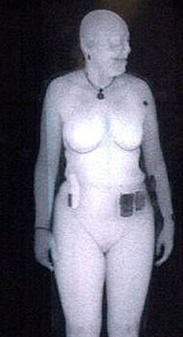 |
|
|
|
|
|
|||
|
By Mike Mitchell |
||||
 |
March 23, 2010 -
The
introduction of full body x-ray screening and explosive trace detection
portals at airports will increase the levels of security and the comfort
of passengers and aviation employees but it may be at a cost. There is a
growing concern that flight crews, and frequent flyers maybe at risk. In
addition it may pose legal questions for children who are being x-rayed.
The studies on X-ray based body scanners have successfully demonstrated that the ionization of the body that they provoke remains below 1 millisivert (mSv). Under this threshold it is generally considered that the risks on health are negligible. A regular passenger who flies only occasionally should in principle not be afraid of going through such scanners. However, those studies do not take into account that the ionization absorbed by the body is cumulative over time. Intensive or very frequent exposures to even small doses of x-ray ionization can result in unacceptable cumulative levels of radiation.
|
|||
|
The effects of radiation on human health must be taken seriously. High levels of exposure can provoke illnesses such as cancer, chromosomal (genetic) damage or cataract. Fortunately, there are alternatives to x-ray based scanners such as millimetre wave imaging which are less harmful to human bodies. This problem does not only affect crews; frequent flyers and other persons already heavily exposed or sensitive to radiation are also concerned. ECA has written to the European Commission requesting the abandonment of x-ray based body scanners as a primary screening tool for crews due to their adverse effects on health and the promotion of other non-aggressive and non-intrusive methods of screening. In that way, aviation security can be enhanced without hindering the crews' and frequent flyers' health. The technology has been proposed as an alternative to personal searches at airport and other security checkpoints, since it can easily penetrate clothing and reveal concealed weapons; however, it raises privacy concerns in that it appears to screeners essentially as a nude picture of the subject, and may allow screeners to gain access to otherwise confidential medical information, such as the fact a passenger uses a colostomy bag. |
||||
|
The ACLU and the
It is "possible
for backscatter X-raying to produce photo-quality images of what's going
on beneath our clothes," thus, according to the TSA, the images have
been distorted with the private areas being blurred. According to the
TSA further distortion is used in the In light of this, some journalists have however expressed concern that this blurring may allow people to carry weapons or certain explosives aboard by attaching the object or substance to their private parts.
The British
newspaper The Guardian has revealed concern among British officials that
the use of such scanners to scan children may be illegal under the
Protection of Children Act 1978, which prohibits the creation and
distribution of indecent images of children. This concern may delay the
introduction routine backscatter scanning in |
| ?AvStop
Online Magazine
Contact
Us
Return To News
|
|
